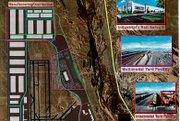Rail Projects Aim to Speed Up Supply Chain
The escalating port traffic in Los Angeles and Long Beach, Calif., has created a domino effect on ground transportation in and out of the region, putting the pressure on not only importers and distributors but also on commuters across Southern California.
Some relief may be in sight, with proposals for two major logistics facilities being planned in Long Beach and the high-desert city of Victorville, Calif.
On Jan. 16 the city of Victorville and officials with Fort Worth, Tex.–based BNSF Railway Co. set the wheels in motion by signing a contract to develop an intermodal logistics facility at Victorville’s Southern California Logistics Airport.
Victorville is located 60 miles north of the Port of Los Angeles along the western border of San Bernardino County. The memorandum of understanding signed by BNSF and Victorville officials calls for the parties to enter exclusive negotiations to develop a rail facility at the SCLA, formerly George Air Force Base. The 3,500-acre complex includes plans for 20 million square feet of manufacturing and distribution space to handle domestic shipments. The facility is expected to generate about 20,000 jobs.
It’s still not known what type of an impact the center will make when completed in 2010, but having rail, truck and air transportation in one location would be a strong solution for domestic shippers, said Victorville officials.
Apparel and textile importers are putting more attention on another intermodal transfer facility about five miles north of the Port of Long Beach. That facility aims to be the key to relieving traffic along the bustling Alameda corridor between Long Beach and Los Angeles.
“Right now, trucks have to haul containers 20 miles up the 710 [Long Beach] freeway to our downtown Los Angeles yard. This would shorten the trip to only a few miles and then be carried by rail,” explained BNSF spokesperson Lena Kent. One train trip could handle more than 200 containers, so the time savings would also be substantial.
BNSF is expected to draft a critical environmental- impact report to the ports by the end of the year, said Kent. Plans are to complete the facility by 2010. The facility would be one of the most modern and environmentally friendly logistics centers in the country, said Kent. BNSF is the only railway member of the Global Environmental Management Initiative, a nonprofit organization dedicated to fostering environmental, health and safety excellence that includes numerous Fortune 500 companies.
The facility, which will be developed on part of the port’s existing classification yard, is located between Sepulveda Boulevard and Pacific Coast Highway. A trucking company currently occupies the existing site.
The ports experienced strong growth last year, with about 16 million containers shipped through the harbors, and that figure is expected to rise about 10 percent in 2007, said Jack Kyser, senior economist for the Los Angeles County Economic Development Corp. Kent added that forecasts are for more than 35 million TEUs (twenty-foot equivalent units) by 2020.
“This is simply a case that the rail capacity right now is extremely tight,” said Kyser. “You have the Hobart yard in East Los Angeles running out of capacity, so these projects would certainly relieve some of the pressure.”
The Victorville facility may also help feed the growing traffic toward the Inland Empire.
“The big distribution facilities are being built further east because the area to the west is built out,” explained Kyser. “You’re seeing facilities being built in places like Moreno Valley and further out now.”
BNSF has attempted to build facilities closer to the ports as well as San Bernardino but has run into grading issues and other obstacles. The railway has been over capacity on the number of containers it can carry. The Victorville complex should relieve some of the pressure at its San Bernardino yard, which handles more than 600,000 containers per year.
BNSF has further plans for its California yards, including a $26 million expansion of parking and stacking capacity at its Hobart intermodal facility in Los Angeles; a $16 million track expansion on its main line near east Barstow, Calif.; and a $9 million expansion of parking capacity at its San Bernardino intermodal facility.






















